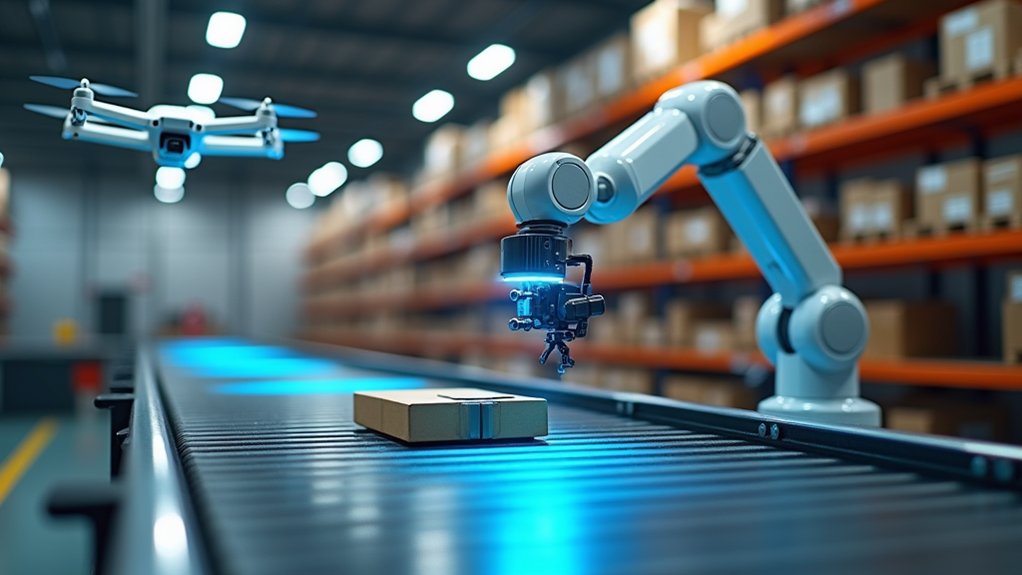As technology rapidly evolves, Computer Vision AI has become increasingly accessible to small and medium-sized businesses, leveling the competitive playing field across industries. While large corporations have traditionally dominated AI adoption, today’s market offers scalable solutions that enable SMBs to enhance their operations through intelligent visual processing and automation.
Implementing Computer Vision AI requires careful planning and expertise to ensure seamless integration with existing business processes. Strategic deployment of this technology can transform quality control, inventory management, and customer experience while providing SMBs with valuable data-driven insights previously available only to enterprise-level organizations.
For sustained success, businesses must focus on selecting and implementing solutions that align with their specific needs and growth objectives. Professional guidance during the AI integration process helps avoid costly missteps and ensures maximum return on investment, allowing SMBs to remain competitive in an increasingly automated marketplace.
Key Takeaways
Computer Vision AI has become increasingly accessible, allowing small and medium-sized businesses to compete effectively with larger enterprises. While implementing these solutions independently can be complex, the right expertise can unlock substantial value for growing companies.
Strategic integration of AI-powered visual systems enables SMBs to achieve enterprise-level efficiency without maintaining extensive in-house technical teams. Professional guidance ensures smooth implementation while avoiding costly trial-and-error approaches.
Computer Vision solutions can transform core business operations – from quality control to inventory management – but success depends on selecting and customizing the right applications for each unique business context. Expert assessment helps identify the most impactful opportunities while ensuring scalability.
As the technology landscape evolves rapidly, partnering with specialists who understand both business needs and technical capabilities helps SMBs stay ahead of the curve. This allows companies to focus on their core competencies while leveraging cutting-edge AI capabilities.
The democratization of Computer Vision creates unprecedented opportunities for smaller businesses, but maximizing ROI requires strategic planning and experienced implementation support to navigate the complex ecosystem of available solutions.

In today’s competitive digital landscape, Computer Vision AI has become increasingly accessible for small and medium-sized businesses looking to enhance their operations. While enterprise-level companies invest millions in custom AI solutions, smaller organizations can now leverage similar capabilities through strategic partnerships and expert guidance. Smart camera applications have revolutionized quality management through automated visual inspection systems.
The integration of Computer Vision AI allows SMBs to automate numerous tasks that traditionally required substantial human resources. From inventory management to quality control, these solutions level the playing field, enabling smaller businesses to compete with larger corporations while maintaining lean operations. With a projected 19.6% CAGR growth through 2030, the computer vision industry offers unprecedented opportunities for business transformation. Modern warehouses are increasingly adopting autonomous drones for efficient inventory tracking and management.
Computer Vision AI empowers small businesses to compete with industry giants by automating labor-intensive tasks while keeping operations efficient and cost-effective.
Professional implementation of AI systems can transform day-to-day business processes. In retail, properly configured computer vision solutions streamline inventory tracking and enhance security. For manufacturing SMBs, expert-deployed AI systems can detect product defects and optimize production lines at a fraction of traditional costs. Augmented reality features enable personalized marketing experiences that enhance customer engagement.
The key to successful AI adoption lies in choosing the right implementation approach. While off-the-shelf solutions may seem attractive, they often fail to address specific business needs or integrate poorly with existing systems. Professional guidance ensures that AI solutions align with business objectives while maximizing return on investment.
For resource-conscious businesses, the expertise of AI integration specialists can prevent costly mistakes and ensure smooth deployment. These partnerships help navigate technical complexities, ensure regulatory compliance, and provide ongoing support – crucial factors often overlooked in self-implemented solutions.
Looking ahead, SMBs that strategically incorporate AI technologies with expert assistance position themselves for sustainable growth. The focus should be on targeted solutions that address specific business challenges rather than broad, unnecessary implementations that strain resources.
The democratization of AI technology presents an unprecedented opportunity for smaller businesses to innovate and grow. However, successful integration requires careful planning, expertise, and ongoing support to truly unlock the transformative potential of these advanced systems.
Frequently Asked Questions
How Much Historical Data Is Needed to Train Computer Vision AI Models?
The data requirements for AI vision systems don’t need to overwhelm small and medium businesses. While enterprise-level solutions may require massive datasets, many practical business applications can achieve excellent results with modest, well-curated collections of relevant images.
For SMBs looking to stay competitive, implementing AI vision solutions can dramatically improve efficiency in areas like quality control, inventory management, and customer service. However, the key lies not in gathering enormous amounts of data, but in working with specialists who understand how to optimize smaller datasets through techniques like data augmentation and transfer learning.
Professional guidance ensures businesses invest in the right-sized solution without unnecessary complexity or overhead. This strategic approach helps organizations maintain their competitive edge while avoiding the common pitfalls of over-engineering or under-performing systems.
Success in AI implementation comes from matching the right solution to specific business needs, with proper attention to data quality, diversity, and accurate labeling – areas where experienced partners can provide invaluable direction and support.
Can Computer Vision AI Systems Work Effectively in Low-Light or Harsh Conditions?
Modern computer vision systems offer small and medium-sized businesses powerful capabilities even in challenging environments. While enterprise-level companies invest millions in AI infrastructure, SMBs can now access similar technologies through strategic implementation and expert guidance.
The ability to operate in low-light conditions and harsh environments has become a game-changing competitive advantage. With properly configured systems showing up to 82% improvement in challenging conditions, businesses can maintain productivity around the clock and in various settings.
However, achieving optimal results requires thorough understanding of hardware specifications, environmental factors, and AI model selection. As the technology continues to evolve rapidly, partnering with experienced AI integration specialists ensures SMBs can implement cost-effective solutions while avoiding costly trial-and-error approaches.
What Security Measures Protect Computer Vision AI Systems From Potential Hacking?
Protecting your business’s AI vision systems requires enterprise-grade security measures that many small and medium-sized businesses find challenging to implement independently. A robust security framework combines multiple protection layers, from sophisticated authentication protocols to encrypted data transmission.
While basic security measures are essential, professional implementation ensures your computer vision applications remain protected against evolving cyber threats. Expert-led security configurations help safeguard sensitive visual data, customer information, and proprietary algorithms – critical assets in today’s competitive landscape.
As cyber threats become more sophisticated, staying ahead requires continuous security updates and monitoring – a resource-intensive process that often extends beyond in-house capabilities. Professional integration ensures your AI systems not only perform optimally but also maintain the highest security standards without straining internal IT resources.
Smart businesses recognize that protecting AI investments requires the same level of expertise as implementing them. Working with experienced partners allows organizations to focus on their core business while maintaining enterprise-level security protocols that adapt to emerging threats.
How Often Should Computer Vision AI Models Be Retrained for Optimal Performance?
Maintaining competitive edge in today’s market requires SMBs to leverage AI solutions effectively, including proper model maintenance and retraining schedules.
While enterprise-level companies have dedicated AI teams, smaller businesses can achieve similar results through strategic partnerships and expert guidance. The key lies in understanding when and how to update AI systems for optimal performance.
Different business scenarios demand different approaches to AI model maintenance. Retail and e-commerce may require frequent updates to match changing consumer behaviors, while manufacturing or logistics could operate on longer intervals.
Professional oversight ensures these schedules align with business goals and resource allocation.
Rather than investing in expensive in-house AI infrastructure and expertise, SMBs can benefit from established frameworks and industry best practices through specialized partners. This approach provides access to enterprise-level AI capabilities while maintaining cost-effectiveness and operational efficiency.
Critical performance monitoring and timely model updates become seamless when handled by experienced teams who understand both the technical requirements and business context.
This allows business owners to focus on core operations while staying competitive in an AI-driven marketplace.
What Happens if Computer Vision AI Makes a Critical Error in Analysis?
Understanding AI Vision Risks for Business Growth
While computer vision AI offers transformative potential for businesses, implementing it requires careful consideration and expertise. Small and medium-sized enterprises must balance innovation with reliability to maintain their competitive edge.
Key considerations when implementing computer vision AI:
- Quality assurance protocols to prevent costly operational errors
- Redundant verification systems to maintain business continuity
- Professional oversight during critical decision-making processes
- Regular system audits and performance monitoring
- Seamless integration with existing business workflows
As markets become increasingly automated, businesses need robust AI implementation strategies that minimize risks while maximizing returns.
Professional guidance ensures proper system architecture, reducing potential errors that could impact operations, customer satisfaction, or regulatory compliance.
Successful AI integration requires:
- Deep understanding of business-specific requirements
- Custom-tailored implementation approaches
- Ongoing technical support and maintenance
- Strategic scaling plans
- Risk management frameworks









